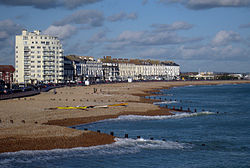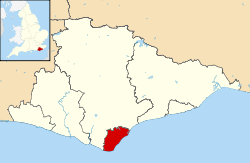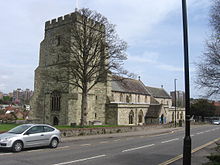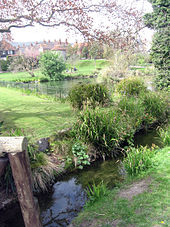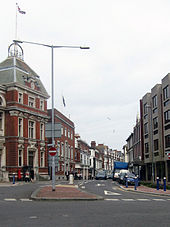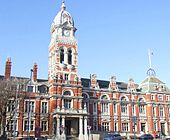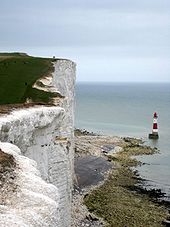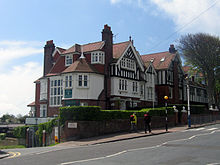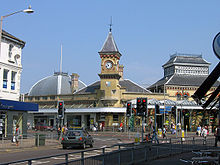- Eastbourne
-
For other places with the same name, see Eastbourne (disambiguation).
Borough of Eastbourne — Town & Borough — Eastbourne seaside Borough of Eastbourne shown within East Sussex Coordinates: 50°46′N 0°17′E / 50.77°N 0.28°E Sovereign state United Kingdom Constituent country England Region South East England Non-metropolitan county East Sussex Status Non-metropolitan district Admin HQ Eastbourne Incorporated Government - Type Non-metropolitan district council - Borough council Eastbourne Borough Council (Liberal Democrat) - Mayor Carolyn Heaps - MPs Stephen Lloyd (Liberal Democrat) Population (2010 est.) - Total 97,000 - Rank 233rd (of 326) Time zone GMT (UTC0) - Summer (DST) BST (UTC+1) Postcodes BN20-23 Area code(s) 01323 ONS code 21UC OS grid reference TV608991 Website eastbourne.gov.uk Eastbourne (
 pronunciation (help·info)) is a large town and borough in East Sussex, on the south coast of England between Brighton and Hastings. The town is situated at the eastern end of the chalk South Downs alongside the high cliff at Beachy Head. The modern town emerged in the early 19th century as a seaside resort, assisted by the arrival of the railway in 1849, and developed a spacious, regular layout.[1]
pronunciation (help·info)) is a large town and borough in East Sussex, on the south coast of England between Brighton and Hastings. The town is situated at the eastern end of the chalk South Downs alongside the high cliff at Beachy Head. The modern town emerged in the early 19th century as a seaside resort, assisted by the arrival of the railway in 1849, and developed a spacious, regular layout.[1]Prior to its Victorian development, the area consisted of the estates of the Duke of Devonshire and others, which had evolved around the village of East Burne. From the Bronze Age onward there were small settlements in and around the "Burne", an ancient stream which ran from what is now Motcombe Gardens down to the sea.[2] During the Middle Ages sheep farming and fishing were the main activities. Eastbourne's earliest claim as a seaside resort was a summer holiday visit by four of King George III's children in 1780. During the Napoleonic Wars, the Wish Tower and the Redoubt were built as defences. In the wake of the fall of France in 1940, the town’s population fell sharply as this part of the south coast was considered a likely invasion zone. The town was badly bombed thus gaining it the dubious reputation of being ‘the most raided town in the southeast’. Thousands of Canadian soldiers were stationed in and around Eastbourne from the summer of 1941 to the run-up to D-Day.
The sheltered position of the main town behind the cliff contributes to Eastbourne's title of sunniest place in Great Britain.[3] The town’s reputation for health and sea breezes was a factor leading to the establishment of many private boarding schools in the 19th century. However, the number of schools started to decline during the inter-war years and today there remain just four. Although Eastbourne has some industrial trading estates, it is essentially a seaside resort and derives its main income from tourism, an element of which includes the provision of English language courses for overseas students. Its facilities include four theatres, numerous parks, a bandstand and museums. The focus of the tourism trade is the four miles (6 km) of shingle beach, lined with a seafront of hotels and guest houses. Eastbourne Pier, built in 1865, is a symbol of Eastbourne and today houses amusement arcades, a nightclub and a public house. It has a rare, working camera obscura.[4] The town has an estimated population of 98,673 as of 2011[update].[5] The town's climate, quiet charm and elegance have contributed to its popularity as a retirement destination and the number of resident pensioners exceeds the national average.
Contents
History
Flint mines and other Stone Age artefacts have been found in the surrounding countryside, and there are Roman remains buried beneath the town, such as a Roman bath and section of pavement between the present pier and the redoubt fortress, and a Roman villa near the entrance to the pier and the present Queens Hotel.[6] An Anglo-Saxon charter, circa 963 AD, describes a landing stage and stream at Bourne. Following the Norman Conquest, the Hundred of what is now Eastbourne, was held by Robert, Count of Mortain, William the Conqueror's half brother. The Domesday Book lists 28 ploughlands, a church, a watermill, fisheries and salt pans.[7]
A charter for a weekly market was granted to Bartholomew de Badlesmere in 1315–16; this increased his status as Lord of the Manor and improved local industry.[8] During the Middle Ages the town was visited by King Henry I and in 1324 by Edward II.[6] Evidence of Eastbourne's medieval past can seen in the fourteenth century Church of St Mary's and the manor house called Bourne Place. In the mid-sixteenth century the house was home to the Burton family,[9] who acquired much of the land on which the present town stands. This manor house is owned by the Duke of Devonshire and was extensively remodelled in the early Georgian era when it was renamed Compton Place. It is one of the two Grade I listed buildings in the town.[10]
Eastbourne's earliest claim as a seaside resort came about following a summer holiday visit by four of King George III's children in 1780 (Princes Edward and Octavius, and Princesses Elizabeth and Sophia).[11] In 1793, following a survey of coastal defences in the southeast, approval was given for the positioning of infantry and artillery to defend the bay between Beachy Head and Hastings from attack by the French. 14 Martello Towers were constructed along the western shore of Pevensey Bay, continuing as far as Tower 73, the Wish Tower at Eastbourne. Several of these towers survive: the Wish Tower is an important feature of the town's seafront, and part of Tower 68 forms the basement of a house on St. Antony's Hill. Between 1805 and 1807, the construction took place of a fortress known as the Eastbourne Redoubt, which was built as a barracks and storage depot, and armed with 10 cannons.[12]
Eastbourne remained an area of small rural settlements until the 19th century. Four villages or hamlets occupied the site of the modern town: Bourne (or, to distinguish it from others of the same name, East Bourne), is now known as Old Town, and this surrounded the bourne (stream) which rises in the present Motcombe Park; Meads, where the Downs meet the coast; South Bourne (near the town hall); and the fishing settlement known simply as Sea Houses, which was situated to the east of the present pier.[12]
By the mid–19th century most of the area had fallen into the hands of two landowners: John Davies Gilbert (the Davies-Gilbert family still own much of the land in Eastbourne and East Dean) and William Cavendish, Earl of Burlington.[8] The Gilbert family's holdings date to the late seventeenth and early eighteenth centuries when barrister Nicholas Gilbert married an Eversfield and Gildredge heiress.[13] (The Gildredges owned much of Eastbourne by 1554. The Gilberts eventually made the Gildredge Manor House their own. Today the Gildredge name lives on in the eponymous park.)[14]
In 1752, a dissertation by Doctor Richard Russell extolled the medicinal benefits of the seaside. His views were of considerable benefit to the south coast and, in due course, Eastbourne became known as “the Empress of Watering Places".[15]
An early plan, for a town named Burlington, was abandoned, but on 14 May 1849 the London, Brighton and South Coast Railway arrived to scenes of great jubilation. With the arrival of the railway, the town's growth accelerated. Cavendish, now the 7th Duke of Devonshire, hired Henry Currey in 1859 to lay out a plan for what was essentially an entire new town – a resort built "for gentlemen by gentlemen". The town grew rapidly from a population of less than 4,000 in 1851 to nearly 35,000 by 1891. In 1883, it was incorporated as a municipal borough; a purpose-built town hall was opened in 1886.[15] This period of growth and elegant development continued for several decades. A royal visit by George V and Queen Mary in March 1935 is commemorated by a plaque on chalet number 2 at Holywell.[16]
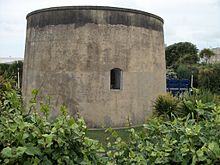 The Wish Tower Martello Tower in Eastbourne
The Wish Tower Martello Tower in Eastbourne
The Second World War saw a change in fortunes.[17] Initially, children were evacuated to Eastbourne on the assumption that they would be safe from German bombs, but soon they had to be evacuated again because after the fall of France in June 1940 it was anticipated that the town would lie in an invasion zone.[8] Part of Operation Sea Lion, the German invasion plan, envisaged landings at Eastbourne.[18] Many people sought safety away from the coast and shut up their houses.[17] Restrictions on visitors forced the closure of most hotels, and private boarding schools moved away.[17] Many of these empty buildings were later taken over by the services.[17] The Royal Navy set up an underwater weapons school,[19] and the Royal Air Force operated radar stations at Beachy Head[15] and on the marshes near Pevensey.[20] Thousands of Canadian soldiers were billeted in and around Eastbourne from July 1941 to the run-up to D-Day.[17] The town suffered badly during the war, with many Victorian and Edwardian buildings damaged or destroyed by air raids. Indeed, by the end of the conflict it was designated by the Home Office to have been ‘the most raided town in the South East region’.[21] The situation was especially bad between May 1942 and June 1943 with hit–and–run raids from fighter–bombers based in northern France.[22]
In the summer of 1956 the town came to national and worldwide attention,[23] when Dr John Bodkin Adams, a general practitioner serving the town's wealthier patients, was arrested for the murder of an elderly widow. Rumours had been circulating since 1935[23] regarding the frequency of his being named in patients' wills (132 times between 1946 and 1956[23]) and the gifts he was given (including two Rolls Royces). Figures of up to 400 murders were reported in British and foreign newspapers,[24] but after a controversial trial at the Old Bailey which gripped the nation[24] for 17 days in March 1957, Adams was found not guilty. He was struck off[25] for 4 years but resumed his practice in Eastbourne in 1961. According to Scotland Yard's archives, he is thought to have killed up to 163 patients in the Eastbourne area.[23]
After the war, development continued, including the growth of Old Town up the hillside (Green Street Farm Estate) and the housing estates of Hampden Park, Willingdon Trees and Langney. During the latter half of the 20th century, there were controversies over the demolition of Pococks, a 15th century manor house on what is now the Rodmill housing estate, and the granting of planning permission for a 19-storey block at the western end of the seafront. The latter project (South Cliff Tower) was realised in 1965 despite a storm of protest led by the newly formed Eastbourne and District Preservation Committee, which later became Eastbourne Civic Society, and was renamed The Eastbourne Society in 1999. Local conservationists also failed to prevent the construction of the glass-plated TGWU conference and holiday centre, but were successful in purchasing Polegate Windmill, thus saving it from demolition and redevelopment.[16][26]
In 1981, a large section of the town centre was replaced by the indoor shops of the Arndale Centre. Most of the expansion took place on the northern and eastern margins of the town, gradually swallowing surrounding villages. However, the richer western part was constrained by the Downs and has remained largely unchanged.
In the 1990s, both growth and controversy accelerated rapidly as a new plan was launched to develop the area known as the Crumbles, a shingle bank on the coast to the east of the town centre. This area, now known as Sovereign Harbour, containing a marina, shops, and several thousand houses, along with luxury flats and apartments, was formerly home to many rare plants. Continued growth in other parts of the town, and the taming of the central marshland into farmland and nature reserves, has turned Eastbourne into the centre of a conurbation, with the appearance from above of a hollow ring. Currently under review is the demolition of some of the town centre, to extend the existing Arndale shopping centre, and the adaptation of several existing roads to form an inner ring road. In 2009 the new Towner Arts centre was opened abutting the listed Congress Theatre built in 1963.[27]
Geography
The South Downs dominate Eastbourne and can be seen from most of the town. These were originally chalk deposits laid down under the sea during the Upper Cretaceous period, and were later lifted by the same tectonic plate movements that formed the European Alps, during the middle Tertiary period.[9] The chalk can be clearly seen along the eroded coastline to the West of the town, in the area known as Beachy Head and the Seven Sisters, where continuous erosion keeps the cliff edge vertical and white. The chalk contains many fossils such as ammonites and nautilus. The town area is built on geologically recent alluvial drift, the result of the silting up of a bay. This changes to Weald clay around the Langney estate.[9]
A part of the South Downs, Willingdon Down is a designated Site of Special Scientific Interest. This is of archaeological interest due to a Neolithic camp and burial grounds. The area is also a nationally uncommon tract of chalk grassland rich in species.[28] Another SSSI which partially falls with the Eastbourne district is Seaford to Beachy Head. This site, of biological and geological interest, covers the coastline between Eastbourne and Seaford, plus the Seven Sisters country park and the Cuckmere valley.[29] Several nature trails lead across the Downs to areas such as the nearby villages of East Dean and Birling Gap, and landmarks like the Seven Sisters, Belle Tout lighthouse and Beachy Head.
Climate
As with the rest of the British Isles and South Coast, Eastbourne experiences a maritime climate with cool summers and mild winters. The local climate is notable for its high sunshine levels, at least relative to much of the rest of England - Eastbourne holds the record for the highest recorded amount of sunshine in a month, 383.9 hours in July 1911.[30] Temperature extremes recorded at Eastbourne since 1960 range from 31.6 °C (88.9 °F) during July 1976,[31] down to −9.7 °C (14.5 °F) In January 1987.[32] Eastbourne's coastal location also means it tends to be milder than most areas, particularly during night - A whole six months of the year have never recorded an air frost, and in July the temperature has never fallen below 8.3 °C (46.9 °F). All temperature figures relate to the period 1960 on.
Climate data for Eastbourne 7m asl, 1971-2000, Extremes 1960- Month Jan Feb Mar Apr May Jun Jul Aug Sep Oct Nov Dec Year Record high °C (°F) 14.8
(58.6)14.7
(58.5)16.7
(62.1)24.0
(75.2)26.3
(79.3)29.0
(84.2)31.6
(88.9)30.4
(86.7)26.9
(80.4)21.4
(70.5)17.4
(63.3)15.2
(59.4)31.6
(88.9)Average high °C (°F) 7.8
(46.0)7.6
(45.7)9.7
(49.5)11.9
(53.4)15.3
(59.5)17.8
(64.0)20.1
(68.2)20.5
(68.9)18.2
(64.8)14.9
(58.8)11.1
(52.0)9.0
(48.2)13.7 Average low °C (°F) 3.6
(38.5)3.2
(37.8)4.5
(40.1)5.9
(42.6)9.1
(48.4)11.8
(53.2)14.2
(57.6)14.4
(57.9)12.4
(54.3)9.7
(49.5)6.3
(43.3)4.7
(40.5)8.3 Record low °C (°F) −9.7
(14.5)−8.8
(16.2)−6.1
(21.0)−1.7
(28.9)0.0
(32.0)3.3
(37.9)8.3
(46.9)7.1
(44.8)5.2
(41.4)0.1
(32.2)−3.7
(25.3)−7.8
(18.0)−9.7
(14.5)Precipitation mm (inches) 81.4
(3.205)51.7
(2.035)59.4
(2.339)48.1
(1.894)46.0
(1.811)54.2
(2.134)46.6
(1.835)48.9
(1.925)74.3
(2.925)98.8
(3.89)92.6
(3.646)87.7
(3.453)789.7
(31.091)Avg. rainy days 12.6 9.7 10.1 8.4 8.3 7.8 6.9 7.0 9.5 11.1 11.3 12.0 114.7 Sunshine hours 64.8 83.3 127.4 187.5 235.0 234.3 243.7 239.6 168.6 125.6 83.7 55.2 1,848.6 Source no. 1: Met Office[33] Source no. 2: Royal Dutch Meteorological Institute/KNMI[34] Districts
Eastbourne's greater area comprises the town of Polegate, and the civil parishes of Willingdon and Jevington, Stone Cross, Pevensey, Westham, and Pevensey Bay village. All are part of the Wealden District. Within Eastbourne's limits are:
- Langney: Langney Rise, Shinewater, Kingsmere, Langney Village, The Marina, Langney Point.
- Hampden Park: Hampden Park Village, Willingdon Trees, Winkney Farm, Ratton.
- Inner areas: Rodmill, Ocklynge, Seaside, Bridgemere, Roselands, Downside.
- Town centre: Town centre, Little Chelsea, Meads, Holywell, Old Town, Upperton.
- Sovereign Harbour: North Harbour, South Harbour.
There was a community known as Norway, Eastbourne in the triangle now bounded by Wartling Road, Seaside and Lottbridge Drove. The name being a corruption of North Way,[35] as this was the route to the North. The area is now a housing estate and the only evidence there was a Norway are a Norway Road and the local church whose sign reads "St Andrew's Church, Norway".
The former fishing hamlet of Holywell (local pronunciation ‘holly well’) was situated by the cliff on a ledge some 400 yards to the southwest of the public garden known as the Holywell Retreat. It was approached from what is now Holywell Road via the lane between the present Helen Gardens and St Bede’s School which leads to the chalk pinnacle formerly known locally as ‘Gibraltar’ or 'The Sugar Loaf'. The ground around the pinnacle was the site of lime kilns also worked by the fishermen.[36] The fishing hamlet at Holywell was taken over by the local water board in 1896[37] to exploit the springs in the cliffs. The water board's successors still own the site, and there is a pumping station but little evidence of the hamlet itself, as by now even most of the foundations of the cottages have gone over the cliff.[38]
Governance
Eastbourne Borough Council is responsible for local governance, with representation provided by twenty seven councillors from nine wards,[39] with elections every four years.[40] The 2011 election resulted in a council made up of 15 Liberal Democrat and 12 Conservative councillors.[41] The council operates out of a Victorian town hall designed by W. Tadman Foulkes, and built between 1884 and 1886 under supervision of Henry Currey, the Duke of Devonshire's architect.[42] East Sussex County Council has responsibility for education, libraries, social services, civil registration, trading standards and transport. Out of the 49 seats, nine are filled by the Eastbourne wards.[43] The 2009 East Sussex County Council election resulted in 29 Conservatives, 13 Liberal Democrats, 4 Labour and 3 Independent, of which Eastbourne provided 6 Liberal Democrats and 3 Conservatives.[44]
The Parliament Constituency of Eastbourne covers a greater area than the nine local wards, extending to the north and the east. Eastbourne is a marginal seat contested between the Conservatives and the Liberal Democrats.[45][46] The Liberal Democrat Member of Parliament for Eastbourne is Stephen Lloyd, who took the seat from the sitting Conservative MP Nigel Waterson with a 3.8% swing on a turnout of 67% in the 2010 General Election.[47] At European level, Eastbourne is represented by the South-East region, which holds ten seats in the European Parliament. The 2009 election returned 4 Conservatives, 2 Liberal Democrats, 2 UK Independence, 1 Labour and 1 Green.[48]
Demographics
Eastbourne has historically been a popular retirement destination on account of its "quiet charm and elegance".[49] The 2001 census showed that it had a larger than average over–60 population (just over 25% of the population being of retirement age as opposed to the UK average of 18.4%).[50] In terms of residents of pensionable age, the parliamentary constituency ranks 6th in England and Wales.[49] However, while the overall population of Eastbourne is growing (between 2001 and 2008 the population grew from 89,800 to 94,800),[51] the age profile is dropping as younger people move into the town.[51] Ethnically, the town is 93.7% white, with small non-white minority groups including Chinese, and white minority groups including East Europeans, Greeks (mainly from Cyprus), and other Europeans.[52] The 2001 census indicated that the largest non-white ethnic group were Chinese; studies conducted by the local council in 2008 indicated that there has been a growth in people arriving from Eastern Europe, particularly Poland.[53] Unemployment is higher than the regional average,[54] with the low skill and education levels of the local population deterring business investment.[55] Health is largely in keeping with the national average, though the number of teenage pregnancies is higher.[56] Violent and sexual crime is higher than average, though thefts and burglaries are lower.[57][58]
Economy
Eastbourne's economy relies largely on tourism and, increasingly, conferencing and foreign language students. The town is normally a short break resort, although hotels can be full during special events such as the Eastbourne International tennis tournament.[15] A 1998 study calculated an annual figure of £48 million of income creation and just over 4000 jobs were directly attributable to tourists. A further £18 million is generated by business conference visitors and foreign language students.[59] Eastbourne Council has developed a seafront strategy in order to boost the tourism economy. Already under way are grants provided for general improvements to accommodation. The regeneration of Seaside, the road running parallel to the coastline, is now complete. The new A22 and Polegate bypass provide a speedier link into the main town.[60] The seafront strategy further outlines priorities for the future, improvements to online bookings and more conference hosting promotion. National marketing campaigns, some based on Eastbourne as a gateway to the South Downs National Park, are in progress.[60] The Sovereign Harbour development is a recent source of revenue for the town with visitors arriving via the harbour.[7]
Tourism
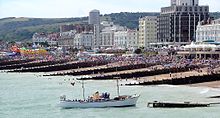 Eastbourne beach and parade with Beachy Head in the background
Eastbourne beach and parade with Beachy Head in the background
The seafront at Eastbourne consists almost entirely of Victorian hotels. Along with its pier and bandstand, this serves to preserve the front in a somewhat timeless manner.[61] The Duke of Devonshire, retains the rights to the seafront buildings and does not allow them to be developed into shops.[37] A stretch of 4 miles (6.4 km) of shingle beach stretches from Sovereign Harbour in the east to Beachy Head in the west. In a 1998 survey 56% of visitors said that the beach and seafront was one of Eastbourne best features, although 10% listed the pebbled beach as a dislike.[59] Other recreation facilities include two swimming pools, three fitness centres and other smaller sports clubs including scuba diving.[62] A children's adventure park is sited at the eastern end of the seafront. There are various other establishments scattered around the town such as crazy golf, go–karting and Laser Quest. The pier is an obvious place to visit and is sometimes used to hold events, such as the international birdman competition held annually, although cancelled in 2005 due to lack of competitors.[63] An annual raft competition takes place where competitors, usually local businesses, circumnavigate the pier in a raft made by themselves, while being attacked by a water-cannon. A major event in the tourist calendar of Eastbourne, now the world's biggest seafront air show,[64] is the annually held 4 day, international air show, 'Airbourne'. Started in 1993,[65] based around a long relationship with the Red Arrows display team, the event features Battle of Britain memorial flights and aircraft from the RAF, USAF and many others.
One of the museums in Eastbourne is How We Lived Then, a museum of shops and local history, with exhibits representing complete scenarios such as shops and houses with life sized dummies. The museum contains more than 100,000 exhibits, covering the period from the 1800s to the Second World War.[66]
Culture
The London Philharmonic Orchestra makes regular appearances and has an annual season at the Congress Theatre. Eastbourne Bandstand lies between the Wish Tower and the pier. It stages the 1812 Firework Concerts, Rock N Roll nights, Big Band concerts, Promenade concerts and Tribute Nights with tributes to artists such as ABBA, Elvis Presley and Queen. There was once a second similar bandstand (also built in 1935) in the "music gardens" near the redoubt fortress. The bandstand was removed to make way for the Pavilion Tearooms but the colonnades built around it are still there (behind the tea rooms). Before 1935 each of these sites had a smaller "birdcage" bandstand; the one in the music gardens having been moved from a rather precarious position opposite the Albion Hotel. The kiosk in the music gardens was originally one of the toll kiosks at the entrance to the pier.[7]
Local radio station Sovereign Radio broadcasts to Eastbourne from nearby Hailsham.[67] There are two other regional radio stations, Heart Sussex, (previously Southern FM) which broadcasts across Sussex from Portslade and BBC Sussex which broadcasts from Brighton.
Theatres
See also: Eastbourne Theatres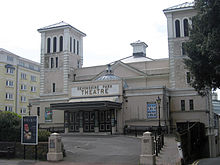 Devonshire Park Theatre (1884)
Devonshire Park Theatre (1884)
Eastbourne has four council-owned theatres; the Grade II* listed[68] Congress Theatre, the Grade II listed Devonshire Park Theatre, the Grade II listed Winter Garden and the Grade II listed Royal Hippodrome Theatre. The Devonshire Park Theatre is a fine example of a Victorian theatre with ornate interior decorations, and the Royal Hippodrome has the longest running summer show in Britain.[69] Other theatre venues in the town include the volunteer-run Underground Theatre, in the basement of the town's Central Library,[70] and The Lamb Theatre, based at the Lamb Inn in Old Town, and launched in August 2009.[71] In 2009, Eastbourne gained a new cultural centre,[72] replacing the Manor House (which has now been sold) as home of the Towner Art Gallery; it is located in the cultural district next to the Congress Theatre and Devonshire Park. Eastbourne has two cinemas—the Curzon Cinema and Cineworld. The Curzon Cinema is a small, family-run, independent cinema in Langney Road, in the town centre. Cineworld is a large Multiplex cinema with six screens, located in The Crumbles Retail Park, near Sovereign Harbour.
Cultural connections
The seafront and the iconic cliff at Beachy Head has been used for many scenes in feature films, and the local council has set up a film liaison unit to encourage and facilitate the shooting of film sequences in and around the town.[73] The 2006 Academy Award-nominated film Notes on a Scandal includes scenes filmed at Beachy Head, Cavendish Hotel and 117 Royal Parade. One of the Harry Potter films also filmed scenes at Beachy Head. Scenes from Half a Sixpence (1969) were filmed on the pier and near to the bandstand. The seafront area was also used for the film Angus, Thongs and Perfect Snogging directed by Gurinder Chadha.[74] A sequence of a rainy day at the seaside for the Doel family has as its backdrop the Wish Tower, the bandstand, the Cavendish Hotel and the pier in the 1987 British/American drama film 84 Charing Cross Road directed by David Hugh Jones.[75]
Television too has used Eastbourne as a backdrop. The series Little Britain had the character Emily Howard strolling along the promenade. Other brief appearances were made in the television series Agatha Christie's Marple, French & Saunders and Foyle's War. One scene in Bang Bang, It's Reeves and Mortimer, was shot in and based around what is now known as "D2L" on Seaside Road. The town was used as a location for the BBC's 2009 series, Psychoville. BBC South East Today and ITV Meridian are the two regional news channels.
Parks and gardens
Eastbourne has numerous parks and gardens, although there are several smaller open spaces including Upperton Gardens, the Carpet Gardens and the Western Lawns. The first public park in Eastbourne was Hampden Park, originally owned by Lord Willingdon and opened on 12 August 1902.[9] Facilities include: football pitches, rugby club, indoor bowls, a large lake (formerly a Decoy pond), lakeside cafe, children's recreation area, tennis courts, BMX and skate facility, disc golf course (target) and woodland. The largest and newest park is Shinewater Park, located on the west side of Langney and opened in 2002. There is a large fishing lake, basketball, football pitches, a BMX and skate park and children's playground.
Gildredge Park is a large open park located between the town centre and Old Town; it is very popular with families and has a children's playground, cafe, tennis courts, disc golf course (target) and bowls lawns. The smaller, adjoining, Manor Gardens combines both lawns and shady areas as well as a rose garden. Until 2005, Manor Gardens was the home of the Towner Gallery. This gallery incorporated a permanent exhibition of local art and historical items, plus temporary art exhibitions of regional and national significance. It was relocated to a new, £8.6 million purpose-built facility adjacent to the Congress Theatre, Devonshire Park which opened on 4 April 2009.
Princes Park obtained its name during a visit by the Duke of Windsor as Prince of Wales in 1931.[35] Located at the eastern end of the seafront, it has a children's playground with paddling pool, cafe, bowls and a large lake, noted for its swans. The lake is used by a nearby water–sports centre, which offers kayak and windsurfing training. Princes Park lake is also home to Eastbourne Model Powerboat Club[76] and Eastbourne Model Yacht Club.[77] Close by are tennis and basketball courts and a football pitch. At the north of the park is Eastbourne United F.C.. Devonshire Park, home to the pre–Wimbledon ladies tennis championships, is located just off the seafront in the towns cultural district. Other parks include: Helen Gardens and the Italian Gardens at the western end of the seafront, Sovereign Park between the main seafront and the marina and Motcombe Gardens in Old Town.
One feature that has always been heavily promoted is Eastbourne's floral displays, most notably the Carpet Gardens along the coastal road near the pier. These displays, and the town as a whole, frequently win awards – such as the 'Coastal Resort B' category in the 2003 Britain in Bloom competition.
Sport
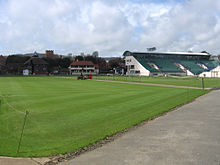 Devonshire Park Lawn Tennis Club – opened 1874
Devonshire Park Lawn Tennis Club – opened 1874
Eastbourne's Devonshire Park is the venue for the Eastbourne International, a tennis tournament held in the town since 1975 and serving as a warm-up to Wimbledon.[78] Previously a women only tournament, in 2009 the Lawn Tennis Association merged it with the men only event the Nottingham Open.[79]
Eastbourne has three senior football clubs: Eastbourne Borough F.C. play in the Conference South,[80] Eastbourne Town F.C. play in the Isthmian League Division One South while Eastbourne United F.C. play in Sussex County League Division 1. The Eastbourne Eagles are a speedway club located at Arlington Stadium, just outside the town. They compete in the Speedway Elite League, the highest level of speedway in England. The stadium also sees stock-car racing on Wednesday evenings in the summer months. Local sports clubs include cricket, hockey, rugby, lacrosse and golf. There is an annual extreme sports festival held at the eastern end of the seafront. Eastbourne Sovereign Sailing Club, on the seafront towards the eastern end, organises dinghy sailing for its members and visitors from Easter to Boxing Day and usually holds a National Championship Series for a popular UK class in the summer months.
Landmarks
Beachy Head
Main article: Beachy HeadBeachy Head cliff, to the west of the town, is an infamous suicide spot. Statistics are not officially published to reduce suicidal mimicry,[81] but unofficial statistics show it to be the third most common suicide spot.[82]
The lighthouse at the foot of the cliff came into operation in October 1902. Although originally manned by two keepers, it has been remotely monitored by Trinity House via a landline since June 1983. Prior to its construction, shipping had been warned by the Belle Tout lighthouse on the cliff top some 1,500 metres to the west. Belle Tout lighthouse was operational from 1834 to 1902, and closed because its light was not visible in mist and low cloud. It became a private residence, but was severely damaged in the Second World War II by Canadian artillery.[83] In 1956, it was rebuilt as a house and remains a dwelling to this day. In March 1999, the structure was moved 55 feet (17 m) back from the cliff edge to save it from plunging into the sea.[84]
Eastbourne Pier
Main article: Eastbourne PierEastbourne Pier was built between 1866 and 1872 at the junction of Grand and Marine Parades. The pier interrupts what would otherwise have been a ribbon development of buildings – to the west, high-class hotels, with modest family hotels and boarding houses to the east.[85] The Eastbourne Pier Company was registered in April 1865 with a capital of £15,000[86] and on 18 April 1866 work began. It was opened by Lord Edward Cavendish on 13 June 1870, although it was not actually completed until two years later. On New Year's Day 1877 the landward half was swept away in a storm. It was rebuilt at a higher level, creating a drop towards the end of the pier. The pier is effectively built on stilts that rest in cups on the sea-bed allowing the whole structure to move during rough weather. It is roughly 300 metres (1000 ft) long. A domed 400-seater pavilion was constructed at a cost of £250 at the seaward end in 1888. A 1000-seater theatre, bar, camera obscura and office suite replaced this in 1899/1901. At the same time, two saloons were built midway along the pier.[87] The camera obscura fell into disuse in the 1960s but was restored in 2003 with a new stairway built to provide access.[85]
Eastbourne Redoubt
Main article: Eastbourne RedoubtEastbourne Redoubt on Royal Parade is one of three examples of a type of fortress built to withstand potential invasion from Napoleon's forces in the early nineteenth century.[88] It houses collections from The Royal Sussex Regiment, The Queen's Royal Irish Hussars, and the Sussex Combined Services Collection; including four Victoria Crosses and General Hans-Jürgen von Arnim's Steyr Automobile 1500A Afrika Korps Staff Car.
Education
Eastbourne’s reputation for health, enhanced by bracing air and sea breezes contributed to the establishment of many independent schools in the 19th century and in 1871,[89] the year which saw the arrival of Queenwood Ladies College, the town was just beginning a period of growth and prosperity.[89] By 1896, Gowland’s Eastbourne Directory listed 76 private schools for boys and girls. However, economic difficulties during the inter-war years saw a gradual decline in the number of independent schools.[90]
In 1930, the headmistress of Clovelly-Kepplestone, a well-established boarding school for girls, referred to "heavy financial losses experienced by schools in the past few years".[90] In 1930, this school was forced to merge its junior and senior departments; in 1931, one of its buildings was sold off, and in 1934 the school closed altogether. Finally, indicative of the changes that would later befall many of the larger buildings in the town,[91] the school was demolished to make way for a block of flats, which was completed in 1939.[90]
The Eastbourne (Blue Book) Directory for 1938 lists 39 independent schools in the town. With the fall of France in June 1940, and the risk of invasion, most left – the majority never to return.[17] By 2007, the number had reduced to just four: St. Andrew's School, Eastbourne College, St Bede’s Preparatory School and Moira House Girls School.
Eastbourne has six state secondary schools, seventeen state primary schools, one primary special school, and two secondary special schools. Parts of the University of Brighton are based in the Meads area of the town. There are several language colleges and schools, with students coming mainly from Europe.[59]
Transport
Eastbourne is connected by road to London by the A22, and to Brighton and Hove and Hastings by the nearby A27. The car is the most used form of transport in the town, with only 6% of journeys taken by bus; the local council transport plan aims to reduce the amount of car usage.[92] Bus services within Eastbourne have been provided by Stagecoach Group under the name Stagecoach in Eastbourne since November 2008, when the company acquired Eastbourne Buses, a service run by the local council, and subsequently the independent company Cavendish Motor Services.[93] Eastbourne Buses had been formed in 1903 by the County Borough of Eastbourne, who were the first local authority in the world authorised to run motor buses.[94] As well as local journeys within the town, Stagecoach also runs routes to Polegate, Hailsham, Tunbridge Wells, Uckfield and East Grinstead at various frequencies, while the two routes to Hastings via Bexhill are run by Stagecoach South East from Hastings. The other main operator into Eastbourne is Brighton & Hove, owned by Go-Ahead Group, which runs frequent services seven days a week from Brighton via Seaford and Newhaven. Limited numbers of additional buses are run by the Cuckmere Community Bus service, and a regular National Express coach service operates daily from London's Victoria Coach Station.
The main railway station is situated in the town centre and is served by Southern. The present station (the town's third), designed by F.D. Bannister, dates from 1886.[15] It was originally on what was termed the Eastbourne Branch[95] from Polegate. There was a rarely-used triangular junction between Polegate and the now-closed Stone Cross which allowed trains to bypass the Branch; the track has now been lifted. Also on the erstwhile Branch is Hampden Park railway station to the north of the town. Regular services along the coast have invariably served Eastbourne. All trains, because of the layout, have to pass through Hampden Park once in each direction. This has the effect of making the Hampden Park level crossing very busy. Indeed, it is thought to be the busiest in the country.[96] Regular services are to London Victoria, Gatwick Airport, Hastings and Ashford International and a commuter service to Brighton. Trains leave from London Victoria to Eastbourne with a journey time of 1hr 36mins.[97] A miniature tramway once ran a mile across "the Crumbles" (then undeveloped) from near Princes Park/Wartling Road towards Langney Point. It opened in 1954 but ceased operation in 1970, relocating to Seaton in Devon after the owners had fallen out with the council;[98] it is now the Seaton Tramway.
Notable people
See also: Eastbourne Blue Plaques and Category:People from EastbourneEastbourne can claim some notable regular visitors. Karl Marx[15] and Frederick Engels were often in the area; the latter's ashes were scattered from Beachy Head at his request.[99] Notable residents include Charles Webb writer of The Graduate, who moved to Eastbourne with his wife in 2006, where they are housed by social services.[100] The pianist Russ Conway was a resident for many years[101] as was Henry Allingham, briefly the world's oldest man when he died in 2009 aged 113. Percy Sillitoe, director of MI5, also lived in the town in the 1950s.[102] The novelist and children's writer Annie Keary died in the town in 1879.[103] Several bands have formed in Eastbourne, including Toploader,[104] Easyworld,[105] and The Mobiles.[106]
Various notable scholars have passed through the Eastbourne education system. Aleister Crowley, occultist and mystic attended Eastbourne College and later edited a chess column for the Eastbourne Gazette.[107] Polar explorer Lawrence Oates attended South Lynn School in Mill Gap Road.[108] George Mallory, the noted mountaineer, attended Glengorse Preparatory School in Chesterfield Road between 1896–1900.[109] Count László Almásy, the basis of the lead character of The English Patient, was educated by a private tutor at Berrow, and was a member of the pioneering Eastbourne Flying Club.[110] Douglas Bader, who became a successful Second World War fighter pilot despite having lost both legs in a flying accident, attended Temple Grove Preparatory School in Compton Place Road.[111] The philosopher A. J. Ayer was a pupil at Ascham St. Vincent's School in Carlisle Road.[112] In addition to Orwell, Connolly, Beaton, Maxwell and Longhurst listed on the St Cyprian's School blue plaque, the writers Alaric Jacob, E. H. W. Meyerstein and Alan Hyman also attended that school. The biographer and historian Philip Ziegler was a pupil as was the music historian Dyneley Hussey and politician, historian and diarist Alan Clark. Other politicians were Richard Wood who had lost both legs in the war, and David Ormsby-Gore later ambassador to the USA. Artists Cedric Morris and David Kindersley also attended the school as did military figures such as General Sir Lashmer Whistler and Major General Robert Foot VC. Pupils with sporting connections include the amateur jockey Anthony Mildmay and Seymour de Lotbiniere Director of Outside Broadcasts at the BBC. Jagaddipendra Narayan was a reigning Maharaja of Cooch Behar while at the school. Other former pupils include the war-blinded life peer Lord Fraser and the submarine commander Rupert Lonsdale.[113] Modern celebrities who studied in the town include Prunella Scales[114] and Eddie Izzard.[115]
In 1993, following a suggestion to Eastbourne Borough Council by Eastbourne Civic Society (now Eastbourne Society), a joint project was set up to erect blue plaques on buildings associated with famous people. The principles for selection are broadly those already established by English Heritage for such plaques in London. The first was erected in November 1994 in Milnthorpe Road at the former home of Sir Ernest Shackleton, the Antarctic explorer.[116]
References
- ^ "Eastbourne – Britannica Online Encyclopedia". library.eb.co.uk. 2011 [last update]. http://library.eb.co.uk/eb/article-9031804?query=Eastbourne&ct=. Retrieved 3 July 2011.
- ^ "Eastbourne Borough Council – History of Eastbourne". eastbourne.gov.uk. 2011 [last update]. http://www.eastbourne.gov.uk/eastbourne/history/history/. Retrieved 3 July 2011.
- ^ "Sunniest Place in Great Britain" (Press release). Eastbourne Borough Council. 22 October 2007. http://www.eastbourne.gov.uk/eastbourne/news/2007/october/sunniest-place. Retrieved 5 May 2008.
- ^ Tim Locke (2011). Slow South Downs & Sussex Coast. Bradt Travel Guides. p. 227. http://books.google.com/books?id=SgWTuzxzYAQC&pg=PA227&dq=Eastbourne+Pier+camera+obscura&hl=en&ei=iXUQTueqDdGr8AOmsaXCDg&sa=X&oi=book_result&ct=result&resnum=3&ved=0CDoQ6AEwAg#v=onepage&q=Eastbourne%20Pier%20camera%20obscura&f=false. Retrieved 3 July 2011.
- ^ "East Sussex in Figures". East Sussex County Council. http://www.eastsussexinfigures.org.uk/webview/. Retrieved 3 May 2009.
- ^ a b Wright, J C (1902), Bygone Eastbourne, Eastbourne: Spottiswoode
- ^ a b c Whitefield-Smith, N. (2004), Eastbourne – A history & celebration, Frith Book Company Ltd, ISBN 1-90493-824-8
- ^ a b c Stevens, Lawrence (1987), A Short History of Eastbourne, Eastbourne: Eastbourne Local History Society, ISBN 0950456071
- ^ a b c d The book of Eastbourne, Eastbourne: Produced for the 99th annual meeting of the British Medical Association, 1931
- ^ "Listed Buildings". Eastbourne Townscape Guide. Eastbourne Borough Council. July 2004. http://www.eastbourne.gov.uk/EasySiteWeb/getresource.axd?AssetID=51326&type=full&servicetype=Inline. Retrieved 12 July 2011.
- ^ Royer (attrib.), James. (1787), East-bourne and its Environs
- ^ a b Milton, Rosemary; Callaghan, Richard (2005), The Redoubt Fortress and Martello Towers of Eastbourne 1804–-2004, Eastbourne: Eastbourne Local History Society, ISBN 0954764706
- ^ "Gildredge, an ancient house and estate," says Sussex historian Mark Antony Lower, "gave name to a family of considerable antiquity, who subsequently had their chief residence at Eastbourne, and gave their name to the manor of Eastbourne-Gildredge."
- ^ "Archive of the Davies-Gilbert Family of Eastbourne, East Sussex, East Sussex Record Office, The National Archives". Nationalarchives.gov.uk. http://www.nationalarchives.gov.uk/a2a/records.aspx?cat=179-gilbert&cid=0. Retrieved 10 July 2011.
- ^ a b c d e f Surtees, Dr John (2002), Eastbourne, A History, Chichester: Phillimore, ISBN 9781860772269
- ^ a b Spears, Harold; Stevens, Lawrence; Crook, Richard; Hodsoll, Vera (1981), Eight Town Walks in Eastbourne, Eastbourne: Eastbourne Civic Society
- ^ a b c d e f Ockenden, Michael (2006), Canucks by the Sea, Eastbourne: Eastbourne Local History Society, ISBN 0954764714
- ^ Ramsey, Winston G (1987). Winston G Ramsey & Gordon Ramsey. ed. The Blitz – Then and Now. 1. After the Battle. p. 294. ISBN 0900913452.
- ^ Allom, VM (1966). "18". Ex Oriente Salus – A Centenary History of Eastbourne College. Eastbourne: Eastbourne College. p. 122.
- ^ Mason, Francis K (1969). "4". Battle over Britain. London: McWhirter Twins. p. 95. "The Awakening"
- ^ Burgess, Pat; Saunders, Andy (1995). Bombers over Sussex. Midhurst: Middleton Press. p. 48. ISBN 1-873793-510.
- ^ Humphrey, George (1989), Wartime Eastbourne, Eastbourne: Beckett Features, ISBN 1871986001
- ^ a b c d Cullen, Pamela V. (2006), A Stranger in Blood: The Case Files on Dr John Bodkin Adams, London: Elliott & Thompson, ISBN 1-904027-19-9
- ^ a b Hallworth, Rodney and Mark Williams, Where there's a will... The sensational life of Dr John Bodkin Adams, Capstan Press, Jersey, 1983. ISBN 0-946797-00-5
- ^ Officially removed from the list of doctors authorized to practise medicine (treat patients) by the General Medical Council
- ^ Clack, Mavis (2007-01). "About us". The Eastbourne Society. Archived from the original on 30 April 2008. http://web.archive.org/web/20080430070645/http://www.eastbournesociety.co.uk/page2/page2.html. Retrieved 9 May 2010.
- ^ Eastbourne Town Centre Regeneration, Eastbourne Borough Council, archived from the original on 27 September 2006, http://web.archive.org/web/20060927081757/http://www.eastbourne.gov.uk/towncentreregeneration, retrieved 24 June 2007
- ^ "County: East Sussex Site Name: Willingdon Down". English Nature. http://www.sssi.naturalengland.org.uk/citation/citation_photo/1002260.pdf. Retrieved 10 July 2011.
- ^ "County: East Sussex, Site Name: Seaford to Beachy Head". English Nature. http://www.english-nature.org.uk/citation/citation_photo/1002008.pdf. Retrieved 10 July 2011.
- ^ UK Weather Records, UK Met Office, http://www.metoffice.gov.uk/climate/uk/extremes/, retrieved 27 November 2008
- ^ "1976 temperature". KNMI. http://eca.knmi.nl/utils/monitordetail.php?seasonid=13&year=1976&indexid=TXx&stationid=1864.
- ^ "1987 temperature". KNMI. http://eca.knmi.nl/utils/monitordetail.php?seasonid=7&year=1987&indexid=TNn&stationid=1864.
- ^ "Met Office: Climate averages 1971–2000". Met Office. July 2011. http://www.metoffice.gov.uk/climate/uk/averages/19712000/sites/eastbourne.html. Retrieved 16 April 2010.
- ^ "Anomaly maps". Eca.knmi.nl. http://eca.knmi.nl/utils/mapserver/anomaly.php?indexcat=**&indexid=TXx&year=1979&seasonid=18&create_image=true&minx=-1111428.5714287&miny=-4687142.8571429&maxx=621904.76190476&maxy=-3387142.8571428&MapSize=560%2C420&imagewidth=560&imageheight=420&mainmap.x=366&mainmap.y=378&CMD=QUERY_POINT&CMD=QUERY_POINT#bottom. Retrieved 2011-11-12.
- ^ a b Milton, John T. (1995), Origins of Eastbourne's Street Names (pamphlet ed.), Eastbourne: Eastbourne Local History Society, ISBN 0950456063
- ^ Eastbourne Local History Society Newsletter (31), March 1979
- ^ a b Eastbourne, an Illustrated Miscellany, Salisbury, Shropshire: Frith Book Company, 2004, ISBN 1904938795
- ^ Eastbourne Local History Society Newsletter (91), March 1979
- ^ Local Elections, Eastbourne Borough Council, http://www.eastbourne.gov.uk/council/elections, retrieved 25 January 2007
- ^ How Local Elections Work, Eastbourne Borough Council, http://www.eastbourne.gov.uk/council/elections/how-elections-work, retrieved 25 January 2007
- ^ "Election Results 2011". Eastbourne Borough Council. http://www.eastbourne.gov.uk/council/elections/elections-2011/. Retrieved 8 July 2011.
- ^ Colin Cunningham (1981). Victorian and Edwardian town halls. Routledge. p. 107. http://books.google.com/books?id=2-E9AAAAIAAJ&pg=PA107&dq=Eastbourne+Town+Hall&hl=en&ei=gpslTuziA4qY8QPl06iFCw&sa=X&oi=book_result&ct=result&resnum=2&ved=0CDQQ6AEwAQ#v=onepage&q=Eastbourne%20Town%20Hall&f=false. Retrieved 19 July 2011.
- ^ East Sussex County Councillors, Eastbourne Borough Council, http://www.eastbourne.gov.uk/council/councillors/county-councillors, retrieved 25 January 2007
- ^ "Find your nearest councillor". eastsussex.gov.uk. East Sussex County Council. http://www.eastsussex.gov.uk/yourcouncil/about/people/councillors/find/default.aspx. Retrieved 18 July 2011.
- ^ "YouElect UK Elections 2010". youelect.org.uk. 2011 [last update]. http://youelect.org.uk/constituency/eastbourne. Retrieved 13 July 2011.
- ^ "Local elections: Eastbourne". BBC News. 4 May 2006. http://news.bbc.co.uk/1/shared/bsp/hi/vote2006/locals/html/21uc.stm. Retrieved 8 July 2011. "Past results"
- ^ Eastbourne result, General Election 2010, BBC Online Network, 7 May 2010, http://news.bbc.co.uk/1/shared/election2010/results/constituency/b56.stm
- ^ "European Parliamentary election 2009". 2009. http://www.electoralcommission.org.uk/elections/results/european/european-parliamentary-election-2009/south-east. Retrieved 8 July 2011. "Results for South East"
- ^ a b "Vote 2001 – Results and Constituencies". BBC. http://news.bbc.co.uk/hi/english/static/vote2001/results_constituencies/constituencies/222.stm. Retrieved 9 July 2011.
- ^ "Population Pyramid – Eastbourne", Census 2001 (National Statistics), http://www.statistics.gov.uk/census2001/pyramids/pages/21UC.asp, retrieved 2 January 2007
- ^ a b "Town population's age profile drops – Local News – Eastbourne Herald". eastbourneherald.co.uk. 2011 [last update]. http://www.eastbourneherald.co.uk/news/local-news/town_population_s_age_profile_drops_1_1416162. Retrieved 19 July 2011.
- ^ "Neighbourhood Statistics – Eastbourne", 2007 Estimate (National Statistics), http://neighbourhood.statistics.gov.uk/dissemination/LeadTableView.do?a=3&b=276950&c=Eastbourne&d=13&e=13&g=441172&i=1001x1003x1004&m=0&r=1&s=1194632354968&enc=1&dsFamilyId=1812, retrieved 14 October 2010
- ^ "Race Equality Scheme 2009–2012". Eastbourne Borough Council. p. 8. http://www.eastbourne.gov.uk/EasySiteWeb/getresource.axd?AssetID=36407&type=full&servicetype=Inline. Retrieved 19 July 2011.
- ^ "Eastbourne Borough Council organisational assessment". oneplace.audit-commission.gov.uk. 2011 [last update]. http://oneplace.audit-commission.gov.uk/infobyarea/region/area/localorganisations/organisation/pages/default.aspx?region=57&area=344&orgId=1187. Retrieved 19 July 2011.
- ^ "Eastbourne Borough Council Local Development Framework". Eastbourne Borough Council. p. 21. http://www.eastbourne.gov.uk/EasySiteWeb/getresource.axd?AssetID=4964&type=full&servicetype=Inline. Retrieved 19 July 2011.
- ^ "Association of Public Health Observatories – Area: Eastbourne CD". apho.org.uk. 2011 [last update]. http://www.apho.org.uk/resource/item.aspx?RID=50438. Retrieved 19 July 2011.
- ^ "Crime rates for BN22 (Eastbourne)". mouseprice.com. 2011 [last update]. http://www.mouseprice.com/area-guide/crime/BN22/Eastbourne. Retrieved 19 July 2011.
- ^ "Dataset: Recorded crime by key offences, 2003–2010 – districts". East Sussex in Figures. East Sussex County Council. http://www.eastsussexinfigures.org.uk/webview/velocity?v=2&mode=cube&cube=http%3A%2F%2Fesfigures01s.escc.gov.uk%3A80%2Fobj%2FfCube%2F302_C1&study=http%3A%2F%2Fesfigures01s.escc.gov.uk%3A80%2Fobj%2FfStudy%2F302. Retrieved 18 July 2011.
- ^ a b c Tourism Study: Visitor Profile & Economic Impact, Report commissioned by Eastbourne Borough Council, 1998
- ^ a b Eastbourne Borough Council Performance Plan 2003/2004, 2003
- ^ "Eastbourne's Story". Eastbourne Borough Council. http://www.eastbourne.gov.uk/EasySiteWeb/getresource.axd?AssetID=226&type=full&servicetype=Inline. Retrieved 10 July 2011.
- ^ Sovereign Divers, http://www.sovereigndivers.co.uk/, retrieved 1 January 2010
- ^ No 'birds' means Birdman scrapped, BBC News, 28 July 2005, http://news.bbc.co.uk/1/hi/england/southern_counties/4722897.stm, retrieved 24 June 2007
- ^ "Eastbourne Airshow". http://www.EastbourneAirshow.com. Retrieved 1 June 2011.
- ^ Calls for airshow to be grounded, BBC News, 3 January 2006, http://news.bbc.co.uk/1/hi/england/southern_counties/4577730.stm, retrieved 24 June 2007
- ^ "How We Lived Then" Museum of Shops and Social History., Sussex Museums, http://www.sussexmuseums.co.uk/how_we_lived_then.htm, retrieved 27 June 2007
- ^ Sovereign Radio, Eastbourne, Media-UK, http://www.mediauk.com/radio/194/107.5-sovereign-radio, retrieved 26 April 2008
- ^ Details from listed building database (469319) Congress Theatre. Images of England. English Heritage..English Heritage
- ^ Eastbourne Borough Council – Theatres, Eastbourne Borough Council, http://www.eastbourne.gov.uk/leisure/theatres, retrieved 6 January 2007
- ^ About the Under Ground Theatre, Eastbourne Arts Centre, http://www.undergroundtheatre.org.uk/index.html, retrieved 18 July 2011
- ^ Oldest town inn begins new life as theatre, Eastbourne Herald, http://www.eastbourneherald.co.uk/entertainment/Oldest-town-inn-begins-new.5533723.jp, retrieved 16 October 2009
- ^ "Towner Opening an ‘Important Minestone’". About Eastbourne. Eastbourne Borough Council. 3 April 2009. http://www.eastbourne.gov.uk/eastbourne/news/2009/april-2009/towner-opening-an-important-milestone/?locale=en. Retrieved 18 July 2011. "Tomorrow’s Towner opening has been hailed an important milestone for England."
- ^ "Film Liaison". Eastbourne Borough Council. http://www.eastbourne.gov.uk/eastbourne/film/. Retrieved 10 July 2011.
- ^ Bamigboye, Baz (19 October 2007), "Girls ganging up for on-screen snogging", Daily Mail (London: Associated Newspapers Ltd), http://www.dailymail.co.uk/pages/live/articles/showbiz/bazbamigboye.html?in_article_id=488450&in_page_id=1794, retrieved 6 January 2008
- ^ 84 Charing Cross Road, Colombia Pictures, ISBN 5035822111134
- ^ "Welcome to Eastbourne Model Powerboat Club Web Site". Eastbourne Model Powerboat Club. http://www.empbc.org.uk/. Retrieved 15 May 2010.
- ^ "Eastbourne and District Model Yacht Club". http://www.edmyc.org.uk/. Retrieved 15 May 2010.
- ^ Jane Ali-Knight, Martin Robertson, Alan Fyall (2008). International Perspectives of Festivals and Events. Elsevier. p. 23. http://books.google.com/books?id=qjazXY83tG4C&pg=PA23&dq=wimbledon+warm-up+event+eastbourne&hl=en&ei=kBUbTo32Bou58gOu3fQx&sa=X&oi=book_result&ct=result&resnum=1&ved=0CDQQ6AEwAA#v=onepage&q=wimbledon%20warm-up%20event%20eastbourne&f=false. Retrieved 11 July 2011.
- ^ "Men and Women's Tennis Merged Events". Eastbourne Borough Council. Archived from the original on 12 June 2008. http://web.archive.org/web/20080612172506/http://www.eastbourne.gov.uk/eastbourne/tourism/tennis/merged-tennis-events. Retrieved 18 May 2008.
- ^ "The Official Football Conference League Website – Tables". footballconference.co.uk. 2011 [last update]. http://www.footballconference.co.uk/tables.php?division_id=21#FullTables. Retrieved 11 July 2011.
- ^ Gunnell, D. (1994), "Reporting Suicide – The effect of media coverage on patterns of self harm", British Medical Journal 308, http://www.bmj.com/cgi/content/full/308/6941/1446
- ^ Hunt, Tom (2006), Cliffs of Despair: A Journey to the Edge, Random House, ISBN 0375507159
- ^ Surtees, Dr John (1997), Beachy Head, Seaford: SB Publications, ISBN 1857701186
- ^ "The 28ft move that took a day", The Argus, 18 March 1999
- ^ a b Crook, Richard (Spring 2010). "Eastbourne Pier – Past, present and future". The Eastbourne Society Observer (182): 10.
- ^ Surtees, Dr John (2002). Eastbourne – a history. Chichester: Phillimore. p. 134. ISBN 1860772269.
- ^ "English Seaside Piers – Eastbourne Pier". English Heritage Trail. http://www.theheritagetrail.co.uk/piers/eastbourne%20pier.htm. Retrieved 13 March 2010.
- ^ Other Redoubts in the South East, Eastbourne Museums, http://www.eastbournemuseums.co.uk/OtherRedoubts.htm, retrieved 27 June 2007
- ^ a b Petrie Carew, Dorothea (1967), Many Years Many Girls, Dublin: The Author
- ^ a b c Eastbourne Local History Society Newsletter (79)
- ^ "The First Years (30th anniversary publication)". Eastbourne Civic Society – The First Years. 1991.
- ^ Local Transport Plan 2006–2011, East Sussex County Council, March 2006
- ^ "Eastbourne Buses was sold for £4million". TR Beckett Newspapers. 27 November 2008. http://www.eastbourneherald.co.uk/news/Eastbourne-Buses-was-sold-for.4740549.jp. Retrieved 29 November 2008.
- ^ Spencer, Dave (1993), Eastbourne Bus Story, Midhurst: Middleton Press, ISBN 1873793170
- ^ Handbook of Stations ... on the Railways of Great Britain and Ireland British Transport Commission (Railway Clearing House) 1956
- ^ "Level crossing warnings at Hampden Park". Eastbourne Herald. Johnston Press Digital Publishing. 16 December 2009. http://www.eastbourneherald.co.uk/news/Level-crossing-warnings-at-Hampden.5915776.jp. Retrieved 3 June 2010.
- ^ National Rail Enquiries, Association of Train Operating Companies, http://nationalrail.co.uk/, retrieved 1 July 2007
- ^ Harley, Robert J (1996), Seaton and Eastbourne Tramways, West Sussex: Middleton Press, ISBN 1873793766
- ^ Kerrigan, Michael (1998), Who lies where (A guide to famous graves), London, England: Fourth Estate Ltd, ISBN 1-85702-258-0
- ^ Hastings, David (27 May 2007), "An arch-seductress graduates to sequel", The Sunday Telegraph (London), http://www.telegraph.co.uk/news/main.jhtml?xml=/news/2007/05/27/wgrad27.xml
- ^ Pianist Russ Conway dies, BBC News, 16 November 2000, http://news.bbc.co.uk/1/hi/entertainment/1027037.stm, retrieved 16 July 2007
- ^ "Directory of Eastbourne". Kelly's Directory. London: Kelly's Directories Ltd. 1957. pp. 181.
- ^ "Anna Keary". Oxforddnb.com. http://www.oxforddnb.com/view/article/15216. Retrieved 10 July 2011.
- ^ Toploader, Much Music, http://www.muchmusic.com/music/artists/bio.asp?artist=362, retrieved 1 July 2007
- ^ Easyworld, BBC Hampshire, http://www.bbc.co.uk/southampton/music/easyworld.shtml, retrieved 1 July 2007
- ^ Annemarie Field (28 December 2006). "EIGHTIES BAND'S ALBUM REVIVAL". Eastbourne Today. Archived from the original on 2008-03-06. http://web.archive.org/web/20080306130124/http://www.eastbourneherald.co.uk/news/EIGHTIES-BAND39S-ALBUM-REVIVAL.1947640.jp. Retrieved 19 July 2011.
- ^ Crowley, Aleister, The Confessions of Aleister Crowley, p. 93, http://www.hermetic.com/crowley/confess/chapter9.html, retrieved 30 June 2007
- ^ Eastbourne Society Newsletter (163)
- ^ Eastbourne Local History Society Newsletter (145)
- ^ Eastbourne Local History Society Newsletter (143)
- ^ Brickhill, Paul (1954), Reach for the Sky: The Story of Douglas Bader DSO, DFC., London: Odhams Press Ltd, ISBN 0002117010
- ^ Ben Rogers A.J. Ayer: A Life 2002 Grove Press ISBN 0-8021-3869-1
- ^ St Cyprian's Chronicle 1914–1930 (at Eastbourne Reference Library)
- ^ Pickering, David, Scales, Prunella, The Museum of Broadcast Communications., http://www.museum.tv/archives/etv/S/htmlS/scalesprune/scalesprune.htm, retrieved 1 July 2007
- ^ Eddie Izzard, www.eddieizzard.com, http://www.eddieizzard.com/eddie/biography/view.php?Chapter=3, retrieved 25 February 2009
- ^ "Blue plaque puts explorer on local map". Evening Argus. 22 November 1994.
External links
- Eastbourne at the Open Directory Project
- Eastbourne Borough Council Official site
- Visit Eastbourne Official tourism site
Ceremonial county of East Sussex Unitary authorities Boroughs or districts Borough of Eastbourne · Borough of Hastings · District of Lewes · District of Rother · District of WealdenMajor settlements Battle · Bexhill-on-Sea · Brighton · Crowborough · Eastbourne · Hailsham · Hastings · Heathfield · Hove · Lewes · Newhaven · Peacehaven · Polegate · Rye · Seaford · Telscombe · Uckfield · Wadhurst
See also: List of civil parishes in East SussexRivers Topics History · Geography · Museums · Parliamentary constituencies · Places · Transport · South Downs · North Downs · Beachy Head · High Weald · Long Man of Wilmington Districts of South East England
Districts of South East EnglandBerkshire 
Buckinghamshire Aylesbury Vale • Chiltern • Milton Keynes • South Bucks • Wycombe
East Sussex Brighton and Hove • Eastbourne • Hastings • Lewes • Rother • Wealden
Hampshire Basingstoke and Deane • East Hampshire • Eastleigh • Fareham • Gosport • Hart • Havant • New Forest • Portsmouth • Rushmoor • Southampton • Test Valley • Winchester
Isle of Wight Kent Ashford • Canterbury • Dartford • Dover • Gravesham • Maidstone • Medway • Sevenoaks • Shepway • Swale • Thanet • Tonbridge and Malling • Tunbridge Wells
Oxfordshire Surrey Elmbridge • Epsom and Ewell • Guildford • Mole Valley • Reigate and Banstead • Runnymede • Spelthorne • Surrey Heath • Tandridge • Waverley • Woking
West Sussex Adur • Arun • Chichester • Crawley • Horsham • Mid Sussex • Worthing
Categories:- Eastbourne
- Local government in East Sussex
- Seaside resorts in England
- Towns in East Sussex
- Non-metropolitan districts of East Sussex
- Local government districts of South East England
Wikimedia Foundation. 2010.

